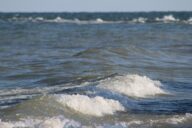Spiny Water Flea
Daniel Kelly | Fondriest Environmental
Native to St. Petersburg, Russia, spiny water fleas have wreaked havoc on zooplankton populations throughout the Great Lakes. Oddly enough, spiny water fleas are considered zooplankton themselves.
Spiny water fleas are microscopic animals that are part of a small order of crustaceans numbering more than 600 species. They are believed to have made it into the Great Lakes through the discharge of ship ballast water. This water is used to fill an area below the hull to keep ships from tipping excessively.
The microscopic animals were found to be living in Lake Ontario in the early 1980s. By 1987, the tiny creatures had made their way to Lake Superior. Spiny water fleas can tolerate brackish water, but are most commonly found among the zooplankton of temperate freshwater lakes, like the Great Lakes. They are most abundant during the summer season.

Spiny Water Flea, Bythotrephes longimanus, under a microscope. (Credit: Great Lakes Environmental Research Laboratory, National Oceanic and Atmospheric Administration)
One of the main advantages that spiny water fleas have is their ability to reproduce rapidly. In the summer especially, this rapid reproduction is accomplished because adult females can generate eggs without mating.
Spiny water fleas typically have a single, long tail that has spines along its length. Adults can grow from a quarter inch to just over a half-inch long. While spiny water fleas can be confused with ordinary zooplankton, inspection with a microscope reveals their actual shape.
Spiny water fleas are relatives of shrimp, lobster and crayfish – in other words, they’re crustaceans, but are also considered a large kind of zooplankton.
Spiny water fleas eat small zooplankton, which are an important food source for fish in larval stages, as well as for forage fish that are prey for larger organisms. So a shift in zooplankton populations can reverberate up an ecosystem’s food chain, affecting many organisms along the way.
Prevent Their Spread
There are several steps that can be taken to minimize the spread of the spiny water flea, including:
- Maintaining good boat cleanliness. It is imperative to keep ships clears of debris or mud that could harbor them. Also, flushing a ship’s ballast area before transferring it to a new water body will also help stop the spread.
- Fishing gear, like nets and bait buckets, should be washed after use.
- Other boat areas that could be full of water, like motors, live wells or bilges, should be drained on land before taking the boat to another water body.
- If the invasive spiny water flea is spotted (difficult to do since they’re microscopic to the human eye), the occurrence should be reported to local authorities.
Sources:










